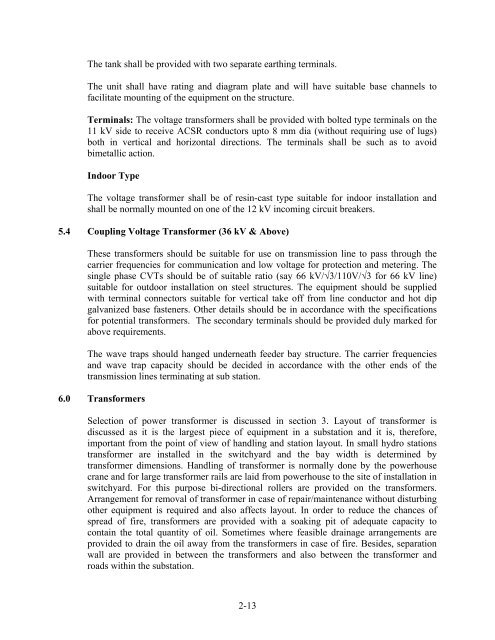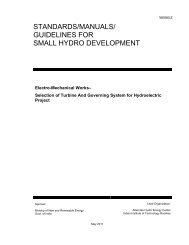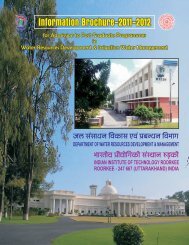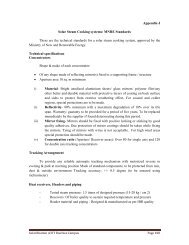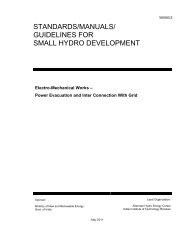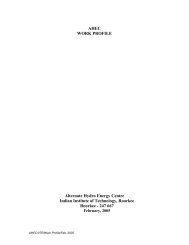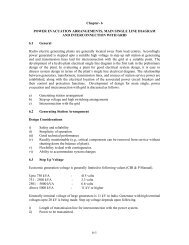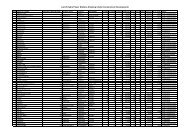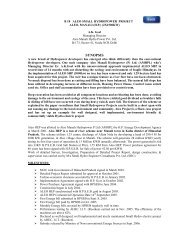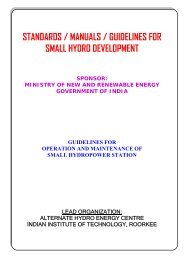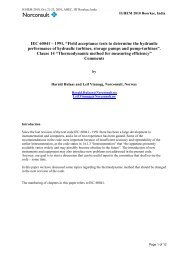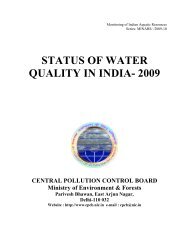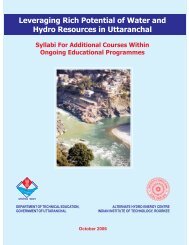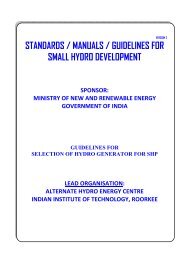standards / manuals / guidelines for small hydro development - AHEC
standards / manuals / guidelines for small hydro development - AHEC
standards / manuals / guidelines for small hydro development - AHEC
Create successful ePaper yourself
Turn your PDF publications into a flip-book with our unique Google optimized e-Paper software.
The tank shall be provided with two separate earthing terminals.The unit shall have rating and diagram plate and will have suitable base channels tofacilitate mounting of the equipment on the structure.Terminals: The voltage trans<strong>for</strong>mers shall be provided with bolted type terminals on the11 kV side to receive ACSR conductors upto 8 mm dia (without requiring use of lugs)both in vertical and horizontal directions. The terminals shall be such as to avoidbimetallic action.Indoor TypeThe voltage trans<strong>for</strong>mer shall be of resin-cast type suitable <strong>for</strong> indoor installation andshall be normally mounted on one of the 12 kV incoming circuit breakers.5.4 Coupling Voltage Trans<strong>for</strong>mer (36 kV & Above)These trans<strong>for</strong>mers should be suitable <strong>for</strong> use on transmission line to pass through thecarrier frequencies <strong>for</strong> communication and low voltage <strong>for</strong> protection and metering. Thesingle phase CVTs should be of suitable ratio (say 66 kV/√3/110V/√3 <strong>for</strong> 66 kV line)suitable <strong>for</strong> outdoor installation on steel structures. The equipment should be suppliedwith terminal connectors suitable <strong>for</strong> vertical take off from line conductor and hot dipgalvanized base fasteners. Other details should be in accordance with the specifications<strong>for</strong> potential trans<strong>for</strong>mers. The secondary terminals should be provided duly marked <strong>for</strong>above requirements.The wave traps should hanged underneath feeder bay structure. The carrier frequenciesand wave trap capacity should be decided in accordance with the other ends of thetransmission lines terminating at sub station.6.0 Trans<strong>for</strong>mersSelection of power trans<strong>for</strong>mer is discussed in section 3. Layout of trans<strong>for</strong>mer isdiscussed as it is the largest piece of equipment in a substation and it is, there<strong>for</strong>e,important from the point of view of handling and station layout. In <strong>small</strong> <strong>hydro</strong> stationstrans<strong>for</strong>mer are installed in the switchyard and the bay width is determined bytrans<strong>for</strong>mer dimensions. Handling of trans<strong>for</strong>mer is normally done by the powerhousecrane and <strong>for</strong> large trans<strong>for</strong>mer rails are laid from powerhouse to the site of installation inswitchyard. For this purpose bi-directional rollers are provided on the trans<strong>for</strong>mers.Arrangement <strong>for</strong> removal of trans<strong>for</strong>mer in case of repair/maintenance without disturbingother equipment is required and also affects layout. In order to reduce the chances ofspread of fire, trans<strong>for</strong>mers are provided with a soaking pit of adequate capacity tocontain the total quantity of oil. Sometimes where feasible drainage arrangements areprovided to drain the oil away from the trans<strong>for</strong>mers in case of fire. Besides, separationwall are provided in between the trans<strong>for</strong>mers and also between the trans<strong>for</strong>mer androads within the substation.2-13


